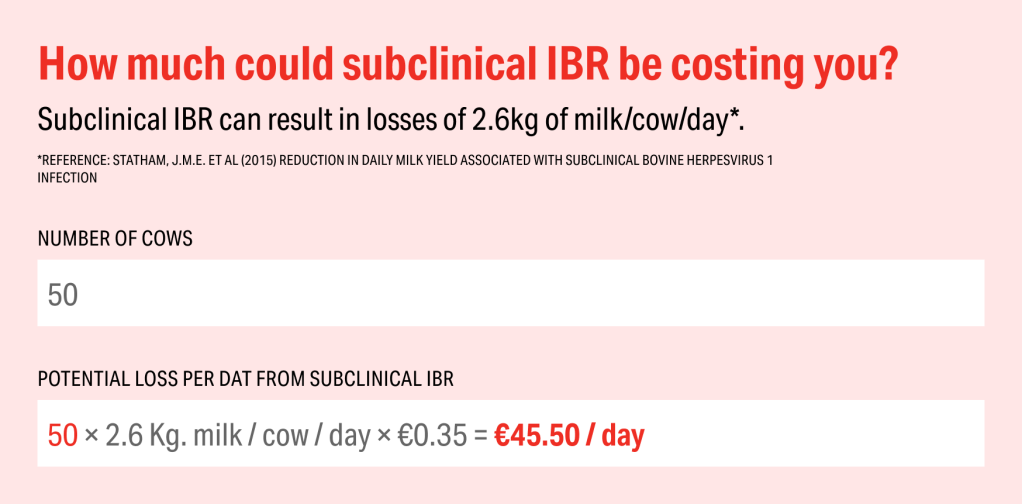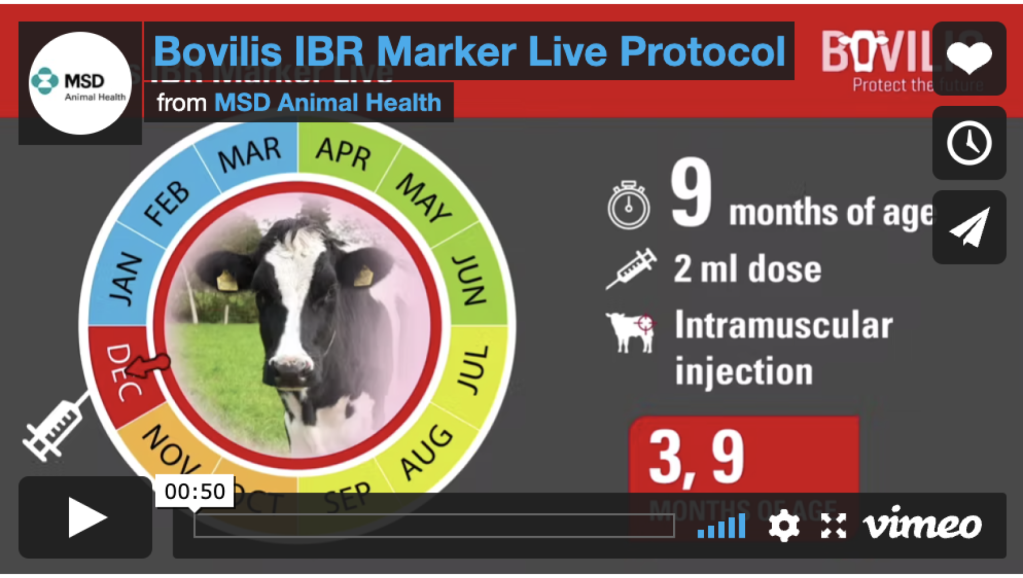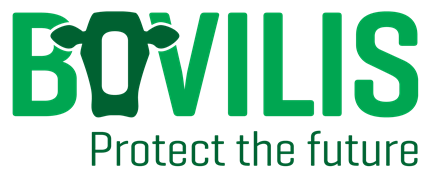

Infectious Bovine Rhinotracheitis (IBR)
Bovilis® IBR Marker Live and Bovilis® IBR Marker INAC
Suspension for injection for cattle and nasal spray for cattle
New Thinking on IBR Control: Calf Vaccination
Salmonellosis is a disease caused by bacteria, of which numerous types exist. In Ireland cattle are most frequently infected with two types of Salmonella species, Salmonella dublin and Salmonella typhimurium.

When should I start vaccinating against IBR?
Some of the agents that cause pneumonia live in the animal’s upper respiratory tract without causing disease. However, under stressful conditions the balance changes and these agents can start to multiply and move to locations such as the lung where they cause pneumonia.
The high risk periods in cattle are those times when the animals are under increased stress. Examples include, change in weather, change in diet, mixing of different groups.

The time to start vaccinating against IBR depends on the particular situation of each herd. MSD Animal Health propose taking the whole herd approach to protecting cattle against IBR by starting with the young stock. Calves from 3 months of age receive a 2 ml shot of Bovilis® IBR Marker Live into the muscle. In herds where IBR is widespread, a 2 ml shot can be administered up the nose from 2 weeks of age. 1 ml in either nostril.
IBR is caused by a virus called Bovine Herpes Virus-1(BHV-1). BHV-1 is unique in that after cattle become infected they become carriers of the disease. The virus can lie latent – or hidden in the animal’s body. It is not possible to tell from looking at the animal if they are a carrier. You need to do a blood test to establish if the animal is a carrier. The disease can reactivate at times of stress. When it reactivates the animal sheds the virus which can result in other animals becoming infected.
The clinical signs associated with the disease are fever and respiratory signs such as runny nose, discharge from the eyes and coughing. IBR in dairy herds is associated with a drop in milk yield. It can also cause abortion.
If your herd is experiencing some of the clinical signs described above and you suspect IBR is causing a problem in your herd talk to your vet. Nasal swabs can be used to identify cattle that are shedding virus and bloods can be used to identify latently infected animals.
Direct nose to nose contact is the main cause of spreading within herds. It can also be spread via mucus or via aerosol, in the air breathed or sneezed out. Airborne spread can occur over distances of up to 5 meters. IBR can be transferred by people, objects and farm utensils and can also be spread by semen from infected bulls.
When latently infected or carrier animals become stressed they shed enough virus to infect naïve (uninfected) animals. These newly infected animals shed much larger quantities of virus and spread it to other naïve animals. It is this spread from recently infected to naïve animal that is responsible for the main spread of virus in an outbreak and spread of disease throughout a naïve herd. The latently infected animals really just act as a reservoir for virus. A newly infected animal can infect up to 6 to 7 naïve in-contact animals, so you can see how easily the virus can spread though the herd when the animals are in close contact.
Once animals are latently infected or carriers they remain carriers for life. You can treat the animals individually as they show clinical signs but to control the disease and its impact on herd production you need to vaccinate.
The old licence claim stated that after the primary course of Bovilis® IBR Marker Live was administered, booster vaccines had to be administered every 6 months thereafter to maintain duration of immunity. The new licence claim states that after the initial injection of Bovilis® IBR Marker Live is administered, a second re-vaccination must be administered 6 months later, booster vaccines can then be administered no greater than every 12 months to maintain duration of immunity Figure 2 below clearly highlights the new Bovilis® IBR
There are two types of IBR vaccines, live vaccines and inactivated vaccines. Vaccinating with the live vaccine results in less shedding of BHV-1 (IBR) virus in newly infected naïve animals than the inactivated vaccine ˡ. There is also limited evidence that using inactivated vaccine can result in a better reduction of shedding by reactivated latently infected animals than live vaccine³. However, a number of studies have showed that live IBR marker vaccines provide better protection against clinical signs than inactivated vaccinesˡ ². Speak to your vet for more information on the advantages of live IBR marker vaccines and which vaccination regime is most suited to your herd circumstances.
Keep an eye on our Twitter page for more information. Bovilis IBR Marker Live can be administer on the same day as Bovipast RSP from 3 weeks of age. More information here
(1) An attenuated bovine herpesvirus 1 vaccine induces better protection than two inactivated marker vaccines, Bosch et al, Veterinary Microbiology 52 (1996) 223-234
(2) H. Kuijk TIERÄRZTLICHE UMSCHAU (2004) 59, 3, p 168 – 172
(3) Bosch, J. C., Kaashoek, M. J., & Van Oirschot, J. T. (1997). Inactivated bovine herpesvirus 1 marker vaccines are more efficacious in reducing virus excretion after reactivation than a live marker vaccine. Vaccine, 15(14), 1512-1517.
PRODUCT RANGE
Bovilis® IBR Marker Live
Download product PDF

Bovilis® IBR Marker INAC
Download product PDF

RELATED

NEWS
Salmonella vaccination: a vital investment for Co. Waterford farmer
18 January 2020
ANIMAL HEALTH
CALF HEALTH
+6 TAGS
Are you on the look out for a new jacket? If the answer is yes, well then we’ve got the competition just for you. Are you on the look out for a new jacket? If …
READ MORE




